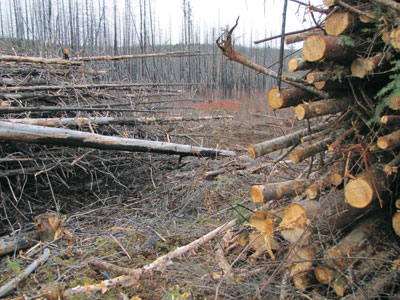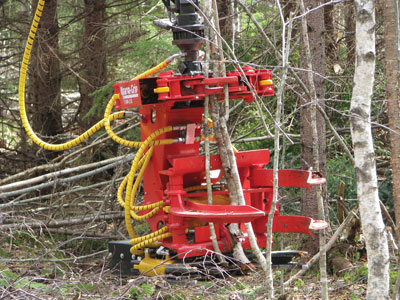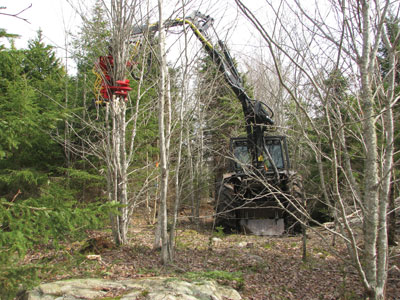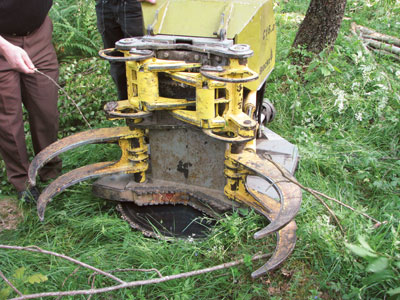
Going Small
February 15, 2012
By Mark Ryans
Small trees are often-overlooked sources of biomass in Canada that can be found in our forests and around communities.
Small trees are often-overlooked sources of biomass in Canada that can be found in our forests and around communities. This potential biomass source – in the form of insect-killed and burnt stands, FireSmart treatments and early stand tending – are just waiting to be utilized. In the latter case, the wood from these trees could have been used for pulpwood, but with the disappearance of woodrooms and mills themselves, there is no longer a market. A developing bioenergy market could offer a win-win solution, while assisting in good forest management and improving our forests for the future.
 |
|
| Stands that have undergone FireSmart treatments can reduce fire risk by eliminating fuel sources and spacing tree crowns, and potentially be used as biomass.
|
In Europe, conventional harvest residues (tops and branches) are already heavily relied upon as a source of biomass with little room for expansion. With most EU countries, especially the Nordic ones, facing higher renewable energy targets by 2020, they have their sights on expanded use of small trees from thinnings.
Because small trees have been used for bioenergy for many years, techniques have already been developed for “energy wood” harvesting, resulting in a variety of felling heads on the market. Any European equipment show will have a dozen or more small heads on display. In FPInnovations’ database of harvesting equipment, we list over 30 makes and models.

|
|
| The Naarva Grip 1500 25-E feller-buncher uses a series of knives for a variety of tasks in wood harvesting, land clearing and thinning operations.
|
|
 |
|
| The Bracke C16a cutting head uses a circular saw instead of knives to cut down and gather small trees for use as biomass.
|
|
 |
|
| Because small trees have been used for bioenergy for many years, techniques have already been developed for energy wood harvesting, resulting in a variety of felling heads hitting the market. |
Some conventional heads have been modified to serve a combination of treatments, retaining their delimbing capability (feed rollers and delimbing knives) but with a different cutting apparatus, for example, the chainsaw replaced by shears. These heads can produce both pulpwood and energy wood, depending upon pricing and stem size. Some can also do a rough delimbing job, thereby leaving smaller branches in the woods while capturing some of the biomass in the top. In most cases, however, the heads are designed for felling and bunching only. Because of the small stem diameter, and with no concern over butt shatter, a variety of simple felling mechanisms can be used. In some ways, designs from almost 40 years ago are back in use, such as smaller-scale Drott shear-head or Forano BJ-20 feller-bunchers. Most have multi-stem handling features, and are affordable and easy to maintain.
Brute force is the norm, but designs range from shears, sickle knives and guillotine knives to circular saws and chainsaws and a chainsaw on a circular disc (see photos). Energy heads have also been designed for mounting on a range of base machines, from conventional harvesters to forwarders (feller-forwarders), excavators and modified agricultural tractors. There is therefore a model for almost any pocketbook and user with any base machine for applications from clear felling to partial cutting.
In partial cut applications, the harvesting method is similar to stand thinning. Where energy wood and pulpwood are produced, there are separate piles of delimbed pulpwood and energy wood still limbed. In strict energy harvests, small trees are left in bunches along the trail. Taller trees are often felled in two stages: one cut halfway up the tree, and another at the stump to facilitate handling and forwarding.
So the heads are available and the applications have been developed, but will we see their use anytime soon? At least three models have been introduced to Canada to date, including the Bracke C16, Naarva Grip and Ponsse EH25. Our experience has also been positive from a treatment point of view.
But, the rub is the cost of treatment.
Any logger knows that the felling cost is primarily dependent upon piece size, and the very small stems result in high felling costs, despite the low price of the heads, multi-stem handling and a lack of concern over stem quality. In Nordic countries, costs are also high, but the higher value of energy wood and subsidies for early stand interventions (for example, Finnish Sustainable Forestry Financing Act, Kemera program) make this biomass source viable. They also recognize the value of stand improvement treatments that support landowners and primary forest industry alike, and are willing to invest in the future.
So the economics are not here yet in Canada, but there should be potential if we combine treatments and programs and have a little more forward thinking. An example could be FireSmart treatments, although the programs are primarily based in western Canada. For those not familiar with FireSmart, the treatments are designed to reduce the fire risk by eliminating fuel sources and spacing tree crowns. Techniques include thinning and mulching, and sometimes removal of the biomass. The costs are also high, but if there were a home for the biomass, in a community-based heat plant, for example, they could be shared and there would be some income for the energy wood. The other advantage of community-based projects is travel distance. The delivered cost of biomass should be the deciding factor, not just the felling cost, and the short travel distance can go a long way toward improving the economics.
There is huge potential for harvesting energy wood in Canada; we just need to have a collective and integrated approach, more community-based projects and some longer vision.
Mark Ryans is with FPInnovations–Feric Division and can be reached at mark.ryans@fpinnovations.ca.
Print this page